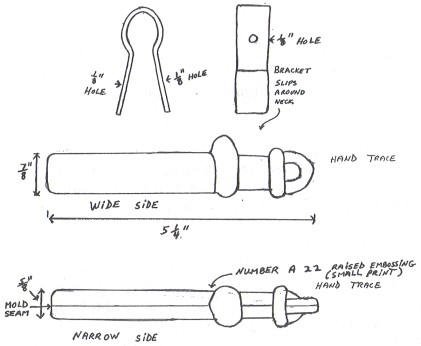Ask Woody
by N. R. Woodward
Reprinted from "Crown Jewels of the Wire", April 1994, page 21
N. R. "Woody" Woodward is the author of THE GLASS INSULATOR IN
AMERICA, 1988 Report and developed
the Consolidated Design Numbers identification system for glass insulators.
The following question comes from Ben Franklin, Lamar, CO
QUESTION: Recently while searching through an old trash dump dating from the
1940's, near an abandoned railroad right-of-way 35 miles north east of Lamar, Co., I found this strange glass item along with several antique
bottles. It is solid clear glass with a slight frosty carnival look. The bracket
appears to be stainless steel with some discoloration. The glass seems to be
made in a mold as it has mold lines on the narrow sides. There is no embossing, but it does have a
22 in small raised embossing on one side near the glass collar for the bracket.
The flat end is ground off flat and does not appear to be broken off of another
part. Could you please help identify this glass as no one around here has ever
seen anything like it.

Sorry, I do not have a definite answer to your question regarding the item
you have found. I can only guess that it was part of a support for neon tubing
in a large electric sign. I've seen some very similar pieces made for that
purpose; and the bracket looks very much like those I've seen. If that is its
source, it would also have a clip mounted on the other end to support the
tubing. The slight iridized appearance probably results from exposure to the
soil during the time it was in the dump.
The following question comes from Gary Short, Chapmansboro, TN
QUESTION: I have a CD 218 Hemingray-660. The markings on the insulators are the same as the one shown
in McDougald's book. What makes this insulator interesting to me is that it is
frosted. Mr. McDougald's book does not have frosted as a color. My question is
could someone do this or would it have been done at the factory. There is a
small chip on the umbrella that shows that it is frosted.
There were never any "frosted" insulators made or sold for use. The
roughened surface would retain moisture and dirt and would defeat the purpose of
the insulator. In some cases old insulators that have been dug appear frosted
due to etching resulting from the soil. But since yours is a relatively new
insulator and, from the photo, appears to be evenly etched over its surface, I
imagine it was done with a chemical used for "frosting" glass. If
indeed it was done at the factory, it would have been only as an experiment to
determine the action of a particular chemical on the glass: and the insulator
would never have been sold for use on the line.
|
CJ HISTORY: N.R. "Woody" Woodward is one of the
recognized pioneers
of the insulator hobby. His first report, published in 1967, and subsequent
reports have given us the Consolidated Design System for glass insulator
identification. His first "Questions Answered by N.R. Woodward"
appeared in the November 1 969 issue. He continues his contributions in
"Ask Woody." |
| 